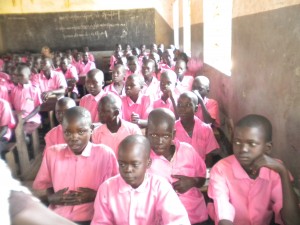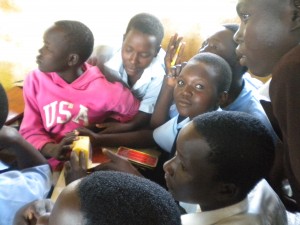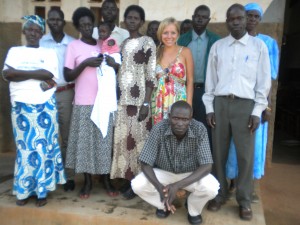So today I ventured out without Shawn as he went to re-teach soap making at the technical school, and I started with a visit to the Padibe Secondary Girls’ School. Deacon David came with me, however, as it’s probably not smart to be a while chick wandering around Padibe. It wouldn’t be terrible, granted, but I’m definitely noticeable here and cannot decipher one dirt road from the next (another thing that amazes me about the people here). We began the morning with a brief meeting with the headmaster who explained the agenda for the day (the headmaster asked that we sit in some classrooms first and evaluate the teachers – yes, I got to be Marty VanHulle for the morning :)) and then we were to have a meeting with him and then with all the teachers.
I started in the sophomore level agricultural classroom while Deacon David was sent to the religious studies class. I will try to explain the experience as objectively as possible, but it is so hard not to compare all of our initiatives and goals in America with the teaching standard here. Objectively, there was lots of note-taking and direct instruction. No formative assessment, really. No practical application (I was thinking that it would be so great for the students to have their own garden plots to experiment with the items that they are learning about – to really see what sort of weeds grow near the type of bean they are learning about. I was also thinking that some of them are “experts†in regards to the planting and maintaining of certain crops and could present to the other students – but there’s my student-centered American bias getting in the way :)).  It was hard to imagine how copying notes about these things might actually help them in the future with the actual practice of farming. I get it – direct instruction and note-taking, basic content knowledge are both important, but the application to how this knowledge works in real life and could be helpful to them outside of the classroom seems even more important than memorizing these things.
Next stop was in the freshman level physics classroom. It’s so interesting to objectively walk into a classroom, not knowing the teacher or the students at all, and immediately feeling how this class was different – the “x factor†that so many of my education professors and administrators have talked about. The teacher quickly reviewed the material that was taught yesterday before teaching new material. He was fun, conversational, yet professional; he was engaged with the students and both teacher and student “felt felt†by one another. Then, before introducing the lesson for the day (time measurement), he activated prior knowledge by talking about the bells and what they signify, about how we may know what time it is (do you think it’s 6:00 pm right now? How might you guess the passage of time? – and I know what you’re thinking, they’re learning this as freshman?!? I was too.). He was calling on the students to check and see if they understood the material… anyway, I won’t go into detail, but this guy was GOOD. The kids were interested, he had clocks for them to use, he played a game with them in which to engage their interest, and he had good closure to the lesson. I was furiously taking notes about universal things that I was seeing that, from my experience, make a good teacher a good teacher.
So this got me thinking – good teaching is good teaching, regardless, right? And kids, African or American, know who is good and who is not. They feel the “x-factor†that I felt the second I walked into that physics classroom. I started to brainstorm different ways that I could be of service here and, after having a long discussion with the headmaster about what type of initiatives they are trying to implemented here – mainly well planned lessons with clear objectives, formative assessment, student engagement, surprisingly, all things that we talk about in America – I think I may have something to offer these teachers and, subsequently, the students through the sharing of the best practices that I have learned oh-so-well, thanks to my experiences with all of the educational pioneers at PHS.
In addition, the headmaster told me that the government here is requiring that all secondary schools are connected to the internet by 2013, but has not provided computers, generators, or electricity, for that matter! (Ah, the logic of politicians and their educational mandates… tsk, tsk, tsk, as the Ugandan women would say… :)). So I am playing around with ideas about what type of work we can continue to do here with the schools. I mean, obviously, computer and internet connection would be awesome and the impetus for any sort of connection to students and teachers in America. Apparently the electricity and internet are on the way (the poles and lines are up…), and if the government is requiring mandatory computer connectivity, it may be helpful to fund-raise for computers (or maybe even look for computer donations), which would open all sorts of doors for student and teacher collaboration across the world. I also started to think about all of the educational resources that we have back in America and how, while this culture is just starting the movement from “sage on the stage†to a student centered classroom, we have been teaching in this manner since I was first trained as a teacher. So, I am thinking, also, of ideas for professional development for the teachers next summer, and hopefully some sort of eventual partnership between students and teachers (the students here are screaming for it – they want to know and connect with students in American so badly).
I obviously cannot commit to any sort of plan as of right now, but today was a good day for observation and brainstorming. The physical things they need –a huge wall to surround their school (this is, ironically, a priority for so many schools here… AH! The power of post-war fear is unimaginable), a new road, new dormitories, better teacher pay (teachers here make $30/month!!! I must also include that the teachers are striking tomorrow… the day of the government enforced testing… because of the low pay and poor benefits – it’s funny to see this parallel connection here as well.), more chairs and tables, more classrooms, more classroom textbooks (they average about 8 math text books for every 67 students), projectors, ELECTRICITY, a full library – may be a bit of a stretch, but I don’t think that all of the gifts that we are able to give start with huge amounts of money.
We’re starting to get tired and the long days of working with the many projects are starting to wear on us a bit. One more full day in Padibe then we start to head back toward the city (we will spend one night in the park where the lions and elephants and monkeys reside and another night at the seminary in Gulu before we leave) on Thursday. I cannot believe how time has proven to slip through our fingers here. Our plane leaves on Saturday night already! I am starting to get a little home sick, so the timing seems about right. Hope everyone at home is doing well. We miss you!
We also published prior to this about my public shaming over the weekend – check it out if you are interested at the “Our Weekend in Padibe” link on the right.



WOW!!!!!!!!!!